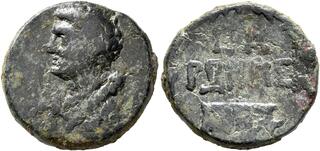| Leu Numismatik AG > Web Auction 28 | Auction date: 9 December 2023 |
| Lot number: 2416 Price realized: 220 CHF (Approx. 250 USD / 232 EUR) Note: Prices do not include buyer's fees. | Show similar lots on CoinArchives Find similar lots in upcoming auctions on |
| Lot description: Uncertain mint in the East, 1st century BC. Bronze (Bronze, 23 mm, 10.86 g, 1 h), RY 1. Bust of Hercules to left, draped with lion's skin (?) and holding club over his left shoulder. Rev. L A / PΩMHΣ Prow to right. Naumann E-Auction 45 (2016), 587 corr. (same dies, but legend misread). RPC -. Of the highest rarity, apparently the second known example, and of great historical interest. Somewhat rough, otherwise, fine. From a European collection, formed before 2005. This highly interesting type only carries the legend L A / PΩMHΣ, meaning 'year one of Rome', but no ethnic or name of a ruler. We are thus left in the dark as to where it was issued, but we may presume from the inscription that it commemorated a new local era that was constituted upon the involvement of Roman authorities in the region. The use of the demotic 'L' as a symbol for a year hints at an origin in the Levante, where several Roman generals, most notably Pompey 'the Great', reshaped the political landscape in the 1st century, prompting many cities to adapt new civic eras. Another option would be the Cyrenaica, which was bequeathed to Rome by Ptolemy Apion in 96 BC and subsequently reorganized as a Roman province. In any case, a date later than the imperatorial era seems unlikely, as local authorities making reference to Roman rule in the imperial era would hardly fail to mention the emperor. The fact that the issue refers to Rome, but not to a ruler, thus points towards a production in pre-Augustean times. As for the issuer, the lack of civic ethnic perhaps indicates that the coins were produced by, or under the auspices of, Roman magistrates or officers, and on a regional rather than on a municipal level. In either case, however, a coin omitting any reference to rulers, generals, or cities, but only to the overarching rule of Rome, represents an extremely careful approach to coinage - especially in an era in which coin types were normally highly politicized. This perhaps reflects a time of unrest in which political ambiguity offered the least area of attack. Regarding the iconography, it should be noted that the rendering of Hercules on the obverse is somewhat reminiscent of denarii of Ti. Quinctius (Crawford 297/1) and P. Cornelius Lentulus Marcellinus, issued in 100 BC (Crawford 329/1). The prow on the reverse, on the other hand, may refer to a naval engagement, of which there were many in the 1th century BC (Actium is just the most famous example), and/or to the production of the coinage in a coastal region. Starting price: 75 CHF |  |



